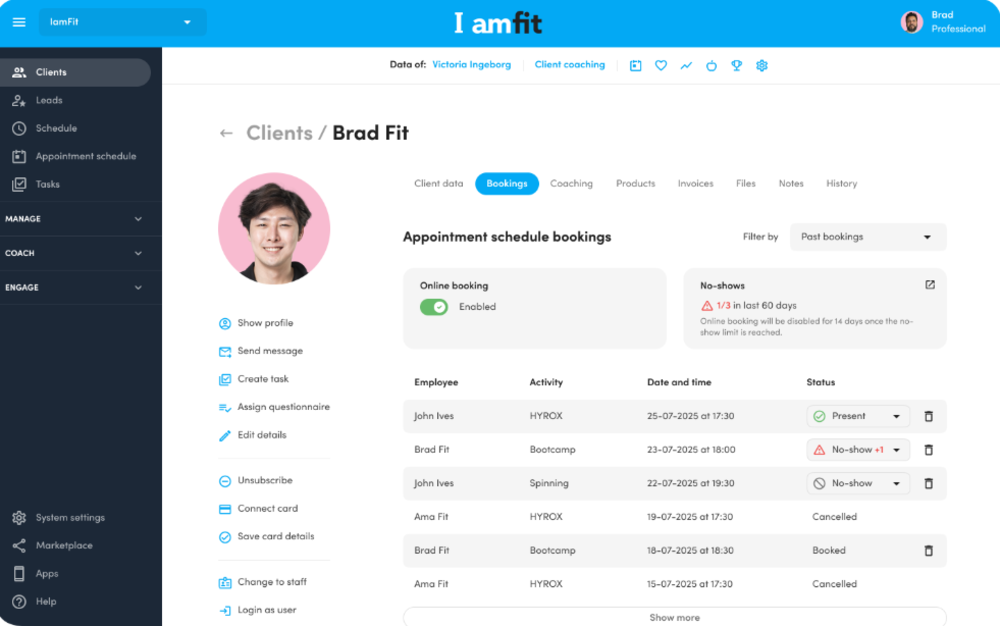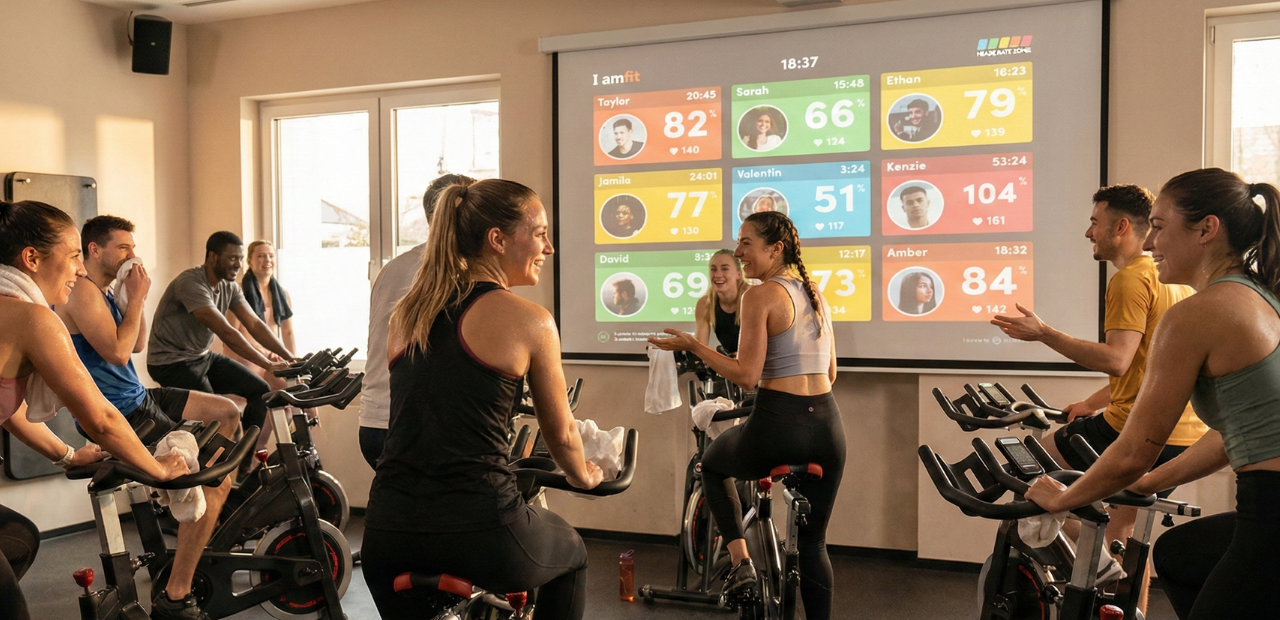Ever walked into your own gym and thought: wow, it feels like rush hour at the subway?
Members fighting for squat racks and free weights. Equipment packed three-deep. That claustrophobic vibe that makes people check their phones instead of hitting another set.
Here’s the uncomfortable truth: if your gym is constantly overcrowded, I’ll be blunt: you’re probably too cheap. 🤑
Not cheap in a bad way, necessarily. But you’ve likely underpriced your memberships, oversold your capacity, or both.
And now you’re paying for it. In member churn, negative reviews, and that knot in your stomach every time peak hours roll around.
The good news? A crowded gym isn’t a death sentence. It’s actually a signal that you’re doing something right (people want to stay active there), but you need to make some strategic changes.
In this guide, we’ll break down why gym overcrowding happens, what it’s really costing you in member satisfaction, and how to fix it without losing members or your sanity.
Let’s turn that packed gym into a profitable, sustainable business.
Why Overcrowding in Gyms Happens

Most gym owners think overcrowding is just a “success problem”—too many members, not enough space. But that’s only scratching the surface.
The real issue? You haven’t set up your business to manage capacity.
Here’s where most gyms go wrong:
You’re underpricing with unlimited access. That $29/month unlimited membership? It attracts everyone, including students from the local university who show up religiously at 6 PM when you’re already packed. You’re not filtering for the right members; you’re just collecting bodies.
You have no usage caps or booking system. 😭 Without any way to accommodate demand or control traffic, everyone floods in during the same 2-3 hour window. Athletes finishing practice, parents after picking kids up from school, office workers done for the day, all descending on your club at once. You’ve created your own bottleneck.
You’re flying blind without data. 📊 Most gym owners have no idea which hours are actually overcrowded, which equipment is overused, or how many people even attend. You can’t fix what you can’t measure.
There are no consequences for no-shows. Members book slots (if you even have a system like Virtuagym) and don’t show up or miss their reserved time. Meanwhile, other paying members get shut out and frustrated, facing long wait times.
The business consequences hit fast:
- ❌ Negative reviews and word-of-mouth damage
- ❌ Higher churn as frustrated members leave
- ❌ Staff burnout from managing chaos
- ❌ Stunted growth, you can’t add more members even if you wanted to
Overcrowding isn’t just about square footage. It’s about business systems you either never built at the beginning or are actively ignoring.
Solutions & Tips To Fix an Overcrowded Gym

Let’s cut to the chase. You can’t magically add square footage overnight, but you can fix your business model.
Here’s how to deal with the challenge:
1. Review Your Pricing Strategy 🕵️♀️
If you’re charging $29/month for unlimited access, congratulations, you’ve created a crowding problem by design.
Cheap memberships attract everyone, including people who treat your gym like a free-for-all. The solution? Raise your prices or add tiered memberships while maintaining quality and saving money on operational chaos.
Here’s what tiered pricing looks like:
- Basic tier ($49/month): Access during off-peak hours only (early mornings 6-10 AM, afternoons 10 AM–4 PM)
- Standard tier ($79/month): Full access, limited to 12 visits per month
- Premium tier ($129/month): Unlimited access + priority booking for fitness classes
Why this works: Higher prices filter for serious members, athletes, working professionals, and dedicated fitness enthusiasts, who value quality over cheap access. Scarcity creates perceived value; most people want what feels exclusive.
Calculation example 🧮
You have 400 members at $29/month = €11,600 revenue. You raise prices and implement tiers. 200 members stay at $49, 150 at $79, 50 at premium $129 = €29,250/month more than double your revenue with fewer members crowding your floor.
2. Cap Memberships or Sessions
This is how boutique gyms and clubs stay profitable without turning into chaos.
Limit your total membership to what your space can actually handle. If your gym comfortably fits 30 people during busy times, don’t sell 800 memberships. The risk of overselling is real; you’ll face declining overall experience and member satisfaction.
Or, if you offer classes, cap class sizes. A 15-person bootcamp delivers better results and a better experience than a 40-person mob.
The business logic: Quality > quantity. Members pay more when they know they’ll actually get equipment, coaching attention, and results. Focus on maintaining excellence rather than playing the numbers game.
3. Use Booking Systems & Credit-Based Memberships
Unlimited drop-ins are killing your flow. Instead, move to a credit system.
How it works:
- Each member gets a set number of credits per month (e.g., 12 credits = 12 sessions)
- They book sessions in advance through your customized app
- No credits = no entry (unless they buy more)
Why this works: It forces members to plan ahead, spreads traffic across the week, and prevents the “everyone shows up at 6 PM” bottleneck. It helps you accommodate everyone fairly across multiple locations if you have them.
You can sell extra credits as an upsell through your webshop. Member runs out mid-summer when they’re working out more? They buy a 5-credit pack for €25. Easy revenue.
4. Handle No-Shows with Accountability Rules
No-shows are costing you money. ⛔ Someone books a spot for a fitness class, doesn’t attend, and a paying member who wanted that slot gets shut out.
Implement consequences:
- Late cancellation fee (€5–10 if they cancel within 2 hours of class)
- Credit deduction for no-shows
- Reward streak attendance with perks (free smoothie, priority booking, etc.)
This keeps your schedule balanced and trains members to respect the system—teaching accountability through practice.
Virtuagym Cancellation System

With Virtuagym’s new Penalty System, managing no-shows just got a whole lot easier. Set clear rules, keep your schedules running smoothly, and make sure clients stay committed.
If someone misses too many sessions, their online booking is automatically paused — no manual work needed. You decide the limits, the rules, and even who gets notified. Smart, simple, and designed to keep your classes full.
If you need strategies to implement this, check out our detailed guide on how to avoid cancellation in your gym.
5. Leverage Business Analytics
You can’t fix what you can’t measure.
If you don’t know when or why overcrowding happens, you’re just guessing. Multiple factors influence traffic patterns.
Track at least the following data:
- Peak hours and bottleneck times
- Most popular fitness classes and equipment (free weights vs. machines)
- No-show rates and patterns
- Member attendance frequency
A gym I used to work at analyzed its data and realized Tuesday/Thursday evenings were 40% more crowded than Monday/Wednesday.
University students and athletes finishing practice were the main factors. They added “HIIT Express” sessions on Tuesdays at 6:30 PM and spread the traffic.
What to do with it: First, use a business analytics software to track your member data. If your 7 PM class is always packed but 6 PM has empty spots, add another 7 PM session or incentivize the 6 PM slot. If leg equipment and free weights are always taken, add more squat racks and reduce redundant machines. Give members room to exercise without long wait times.
6. Stagger Peak Hours with Incentives
Let’s be honest, what I am about to say isn’t rocket science. Everyone knows gyms are dead at 11 AM and pure chaos at 6 PM.
The trick is actually doing something with it. Shift members to off-peak hours with smart incentives, small perks, or creative scheduling that makes training outside rush hour the obvious win.
Tactics that work:
- Off-peak discount: 20% off your gym membership for daytime-only access
- Lunchtime express sessions: 30-minute workouts marketed to remote workers
- Early bird perks: Free coffee or priority equipment access for the early mornings, 6 AM crew
Why it works: You’re filling empty capacity while reducing peak-hour stress. It’s a win-win. Parents can join morning sessions after dropping kids at school, while freshmen and university students might prefer afternoon slots between classes.
7. Upsell Premium Memberships or Small-Group Options
Want to reduce floor crowding and make more money? Create VIP tiers that include personal training.
Premium membership perks:
- Priority booking for all fitness classes
- Access to small-group training (max 6 people)
- Monthly personal training check-in included
- Dedicated equipment area during peak hours
Calculation example:
You convert 30 members to premium at €149/month (vs. €79 standard) = €2,100 extra monthly revenue. Those 30 members now train in small groups or off-peak, reducing floor traffic by 10–15%.
Small-group personal training also lets you charge more per session while delivering a better experience with focused teaching and attention.
8. Improve Space Utilization
Before you blame square footage, check if you’re actually using your space efficiently. Give your equipment room to breathe.
Quick wins:
- Replace bulky single-purpose machines with multi-use rigs (cable systems, adjustable benches, functional trainers)
- Create dedicated zones: strength area with free weights, cardio area, functional training space
- Use vertical space for storage (wall-mounted racks, plate trees)
Gyms that have replaced underutilized cardio equipment with multi-functional training rigs typically report significant improvements in usable floor space and member satisfaction.
9. Offer Hybrid or Online Coaching Options
Not every member needs to physically be in your gym or club. Push some members toward hybrid memberships that combine in-house sessions and virtual classes.
What hybrid coaching looks like:
- 2 in-gym sessions per week + 2 app-based workouts at home
- Virtual classes via video for members resting between heavy training days
- Programming delivered through your app
Why it works: Members stay active and paying, but you reduce physical crowding. Plus, hybrid members often pay more because they’re getting personalized programming. It’s perfect for busy parents, students juggling school, or anyone who can’t always make it to physical locations.
Calculation example:
You move 50 members to a hybrid model at €99/month (vs. €79 unlimited in-gym). That’s €1,000 extra monthly revenue with less wear on your equipment and less crowding.
How to Implement these Strategies Without Losing Members

Change is scary for members. If you suddenly announce “We’re raising prices and capping memberships,” people will panic and assume you’re just being greedy.
Your Messaging Matters More Than the Change Itself
People don’t resist change; they resist feeling worse off. So your job is to show them they’re getting more value, not less access. Focus on the overall experience.
❌ Bad messaging: “Due to overcrowding, we’re limiting memberships and raising prices effective immediately.”
✅ Good messaging: “We’re making changes to ensure every member gets the space, equipment access, and coaching attention they deserve. Here’s what’s improving…”
See the difference? One sounds like a punishment. The other sounds like you’re investing in their experience.
Communicate Early and Transparently
Don’t blindside your members with sudden changes. Give them advance notice and explain why you’re doing it. Transparency builds trust.
Timeline for rolling out changes:
4 weeks before: Announce the upcoming changes via email, app notification, and in-gym signage. Explain the problem (crowded gym, long wait times) and the solution (new systems to accommodate everyone fairly).
3 weeks before: Host a Q&A session (in-person or virtual) where members can attend and ask questions. Address concerns directly.
2 weeks before: Send a detailed breakdown of what’s changing and how it benefits them specifically.
1 week before: Final reminder with clear instructions on how the new system works.
Launch day: Make staff available to help members navigate the new booking system, pricing tiers, or credit structure.
Members will forgive a price increase if they understand it means better equipment, cleaner facilities, or no more long wait times for free weights.
Lead with Benefits, Not Features
Don’t just list what’s changing, tell members what they gain.
Instead of: “We’re introducing a booking system."
Say: “You’ll now be able to reserve your spot in advance, so you never show up to a packed gym again.”
Instead of: “We’re raising prices by €20/month."
Say: “Your membership now includes priority booking for fitness classes, upgraded equipment, and extended hours, so you get more value for your investment.”
Instead of: “We’re capping memberships."
Say: “We’re limiting new sign-ups to protect the overall experience for our current members. You’ll never have to deal with long wait times for equipment again.”
Handle Pushback with Empathy (But Don’t Back Down)
Some members will complain no matter what. That’s fine. Listen to them, acknowledge their concerns, but don’t reverse good decisions because of a vocal minority.
When someone says, “I liked it better when I could just show up whenever.”
Respond with: “I totally get that, spontaneity is great. But we heard from so many members who were frustrated by overcrowding and couldn’t exercise when they wanted. This system ensures everyone gets a fair shot at equipment. Give it two weeks, and if it’s still not working for you, let’s talk about other options.”
90% of complaints disappear once people experience the benefits. The other 10% might leave, and honestly, they’re probably the ones who were causing the overcrowding problem in the first place.
Conclusion
Overcrowding isn’t a sign of success. It’s a warning signal that your business model needs adjusting.
A packed gym might feel good in the moment, but it’s quietly destroying your reputation, burning out your staff, and pushing your best members toward the exit. Meanwhile, you’re leaving serious money on the table by underpricing and underselling your value.
The good news is that you don’t need a bigger space or a massive investment to fix this. You need smarter systems: better pricing, booking tools, data analytics, and accountability structures that actually manage capacity instead of letting chaos rule.
When you raise your value and balance demand, everything shifts. Members are happier because they can actually use the equipment and attend the classes they want.
Your team is less stressed because they’re not managing a daily stampede. And your margins? They improve because you’re charging what you’re worth and retaining members longer.
This isn’t about restricting access, it’s about creating an experience people actually want to pay for.



